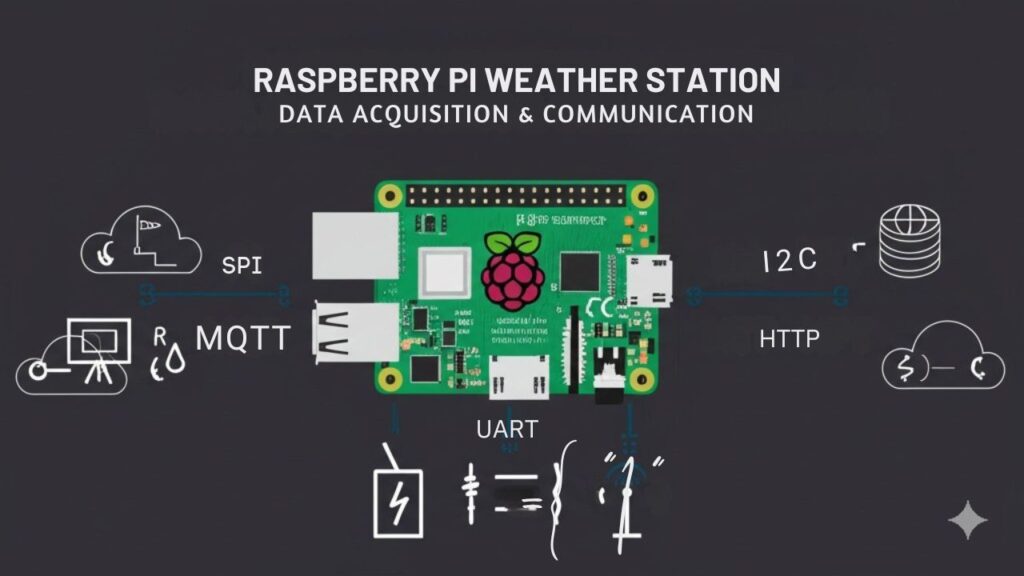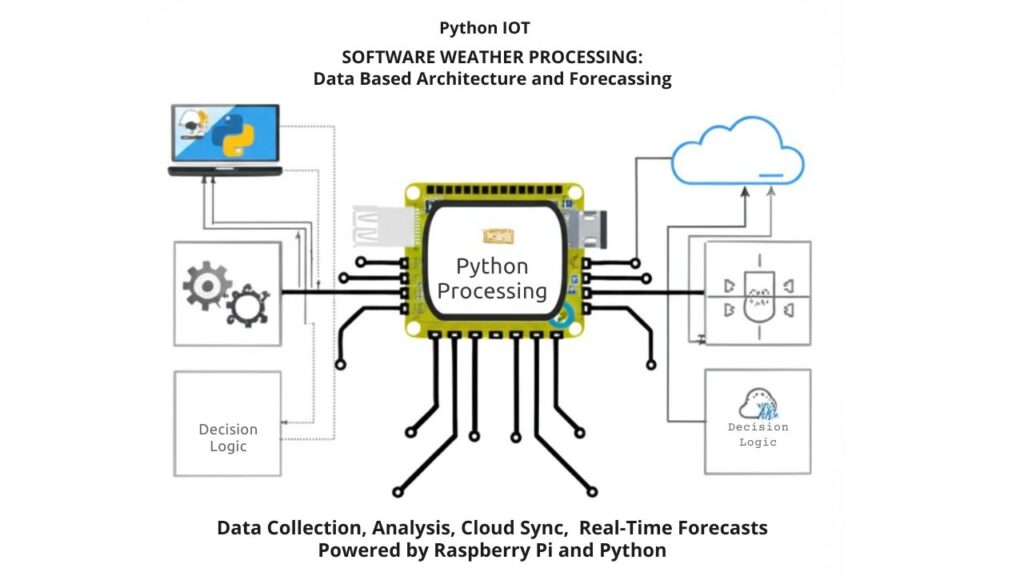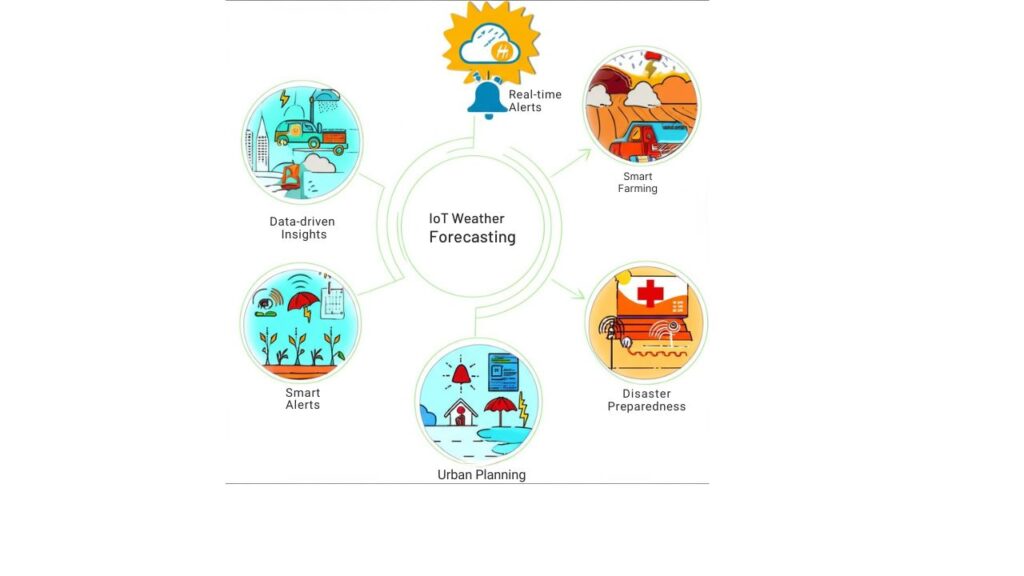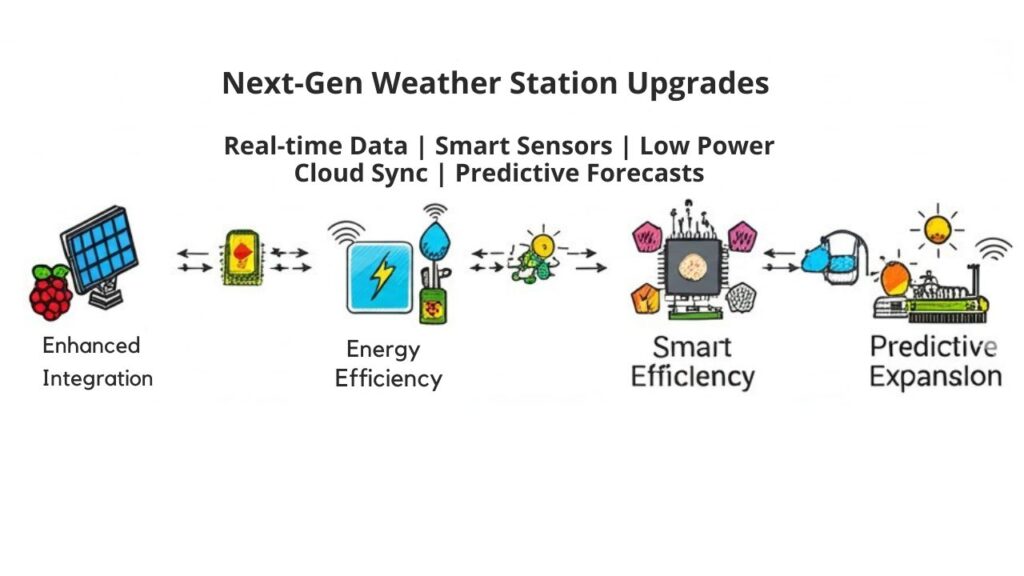Why a Raspberry Pi IoT Weather Monitoring System?
Did you know that over 60% of localized weather anomalies aren’t captured by conventional meteorological networks? By integrating sensors like the DHT22 and BMP280 with a Raspberry Pi, you can bridge these data gaps. Let’s explore building a scalable, modular Raspberry Pi IoT weather monitoring station. You’ll manage precise data collection, seamless cloud communication, and predictive analytics—all using Python. Unleash how these systems empower smarter forecasting and enable robust environmental decision-making in ways traditional setups simply can’t.
Key Takeaways
- Raspberry Pi 4 offers reliable processing and integrated GPIOs for connecting a wide range of digital weather sensors.
- Modular Python code and libraries like Adafruit_DHT and GPIO Zero streamline sensor integration and cloud data transmission.
- Real-time data collection enables monitoring of temperature, humidity, air pressure, wind, and rainfall from multiple locations.
- Secure Wi-Fi communication using HTTP and lightweight protocols ensures encrypted, authenticated data transfer to IoT cloud platforms.
- IoT-connected weather stations support remote access, predictive analytics, and applications in agriculture, disaster management, and smart cities.
Key Hardware Components and Sensor Selection
Selecting the right hardware components is critical for building a robust Raspberry Pi IoT weather monitoring system that’s both scalable and reliable.
Careful hardware selection lays the foundation for a scalable and reliable Raspberry Pi IoT weather monitoring system.
You’ll want to prioritize sensor compatibility by choosing the Raspberry Pi 4 for its integrated GPIO headers and strong processing capabilities, which let you interface directly with digital sensors like DHT22, DS18B20, or BMP280.
Hardware optimization means matching sensor interfaces—using I2C for multi-parameter sensors (HTU21D or BME280) and 1-wire protocols for chainable temperature probes.
For rainfall and soil monitoring, guarantee ADC modules are included to bridge analog sensors with your digital GPIOs.
As many weather monitoring applications require real-time monitoring of weather conditions, it’s important to select sensors and interfaces that provide fast, consistent, and accurate readings across temperature, humidity, and rainfall parameters.
Raspberry Pi serves as an affordable and accessible hardware platform that greatly benefits educational weather projects by lowering entry barriers and offering broad compatibility with various sensors.
Data Acquisition Methods and Communication Protocols

Once you’ve configured your hardware stack—with sensor interfaces and network modules aligned for peak performance—you need a robust approach for acquiring and communicating data. Embrace real time acquisition by leveraging your sensors’ ability to collect and transfer weather data every second, feeding into a resilient and scalable network. With multi source integration, you’ll aggregate data from temperature, humidity, and pressure sensors, ensuring thorough coverage.
For seamless data flow, connect your Raspberry Pi to the cloud via Wi-Fi, using HTTP and lightweight messaging protocols. These methods facilitate remote access, high reliability, and system integration for future expansion. Raspberry Pi IoT Weather Monitoring Systems provide real-time updates, automate data collection, are customizable for specific weather parameters, enable remote access, and are cost-effective], making them particularly effective for real-time monitoring applications. Implement encryption and authentication for secure transmission. By utilizing IoT-enhanced forecasting capabilities, your Raspberry Pi IoT weather monitoring system can integrate data from multiple sources for higher accuracy and improved operational outcomes.
| Data Type | Communication Protocol | Integration Level |
|---|---|---|
| Temperature | HTTP, MQTT | Multi source |
| Humidity | Wi-Fi | Real time |
| Pressure | Cloud API | Scalable |
Monitoring Essential Weather Parameters

Although you’ve assembled a capable hardware and communication stack, the true value of an Raspberry Pi IoT weather monitoring system lies in its ability to accurately track essential weather parameters in real time.
By integrating temperature, humidity, air pressure, wind speed, wind direction, and rainfall sensors, you guarantee that each environmental variable is precisely monitored for maximum data accuracy.
Real-time parameter tracking empowers robust impact assessment for sectors like agriculture, energy, and disaster management, enabling informed, responsive actions. Microclimates play a crucial role in localized forecasting, as their unique conditions can significantly influence weather patterns that impact many of these sectors.
In addition, accurate microclimate analysis and predictive models depend on thorough, sensor-driven datasets. By deploying weather sensors within smart cities, you facilitate the collection of detailed environmental data that supports infrastructure development and resource allocation.
As you aim for future scalability, system integration with advanced analytics and AI becomes seamless.
Ultimately, this approach delivers actionable insights, supports data-driven planning, and sets the foundation for innovative infrastructure and environmental decision-making.
Python-Based Software Architecture and Development

You should structure your Python code into modular components to clearly separate sensor input, data processing, and user interface logic. Integrate sensor libraries such as Adafruit, DHT or smbus to streamline hardware communication and simplify future updates or sensor additions. This approach guarantees reliable system integration and lays the groundwork for scalable enhancements in your Raspberry Pi IoT weather monitoring project. By consistently applying a modular architecture that reflects the division between functional roles, you build upon the separation of concerns between hardware interfacing, computational logic, and user-facing features aligns with industry best practices seen in successful web-based weather forecasting applications.
Modular Python Code Structure
While complex IoT weather monitoring systems demand adaptability and sustainable growth, employing modular Python code structure lays a robust foundation for clarity, maintainability, and future scalability.
By embracing modular design, you divide your project into clear, logically grouped modules—each encapsulating related functions or classes. Thoughtful repository structure is crucial for efficient development and an enhanced experience for both users and contributors. Organize code into designated directories, such as a discrete `src` folder, ensuring production code, tests, and configs remain independent.
Dependency management plays a critical role in minimizing conflicts and smoothing collaboration as your project grows.
Structure your code organization with concise module and package names, grouping related functionality and leveraging Python’s package hierarchy through sub-packages and `__init__.py` files. Maintain separation of concerns by distinct modules for utility, configuration, and main application logic.
Adhere to best practices—absolute imports, explicit namespaces, and object-oriented principles—for reusable, extensible code that’s easy to test and integrate as your system evolves.
Sensor Integration Libraries
Building on a modular Python codebase enables you to efficiently incorporate a wide array of sensor integration libraries tailored for Raspberry Pi IoT weather monitoring systems.
To maximize sensor compatibility, leverage versatile libraries such as GPIO Zero or RPi.GPIO for digital and analog input handling, while Adafruit CircuitPython accelerates integration of specific modules like the BME280 or DHT series.
For scenarios involving hybrid hardware, pyFirmata extends support to Arduino boards, enhancing versatility. Python provides cross-platform compatibility, allowing your codebase to easily operate across systems such as Linux, Windows, MacOS, and Raspberry Pi, further streamlining development.
Prioritize library performance by evaluating responsiveness, resource usage, and scalability. Asyncio-driven polling guarantees non-blocking operation even with multiple sensor nodes, and harnessing specialized packages like pySerial or bluepy broadens protocol support to UART and BLE sensors.
Python’s critical role in IoT development stems from its extensive ecosystem and simple syntax, making it easier to adapt your integration approach as new sensors or protocols emerge. This strategic approach delivers robust integration, future proofs your system, and optimizes data pipeline reliability.
Real-World Applications in Weather Data and Predictive Analytics

How do industries leverage advanced weather data and predictive analytics to drive operational efficiency and resilience? By integrating real time predictions into your workflows, you can optimize resource allocation and anticipate climate impact with technical precision.
In agriculture, granular forecasts inform planting and irrigation, maximizing yield. Predictive analytics: a new way to understand weather provides a single source of truth, allowing businesses to target risk mitigation precisely. For the energy sector, accurate modeling of wind and solar conditions allows you to stabilize grids and forecast generation.
Disaster management teams use predictive analytics to automate risk assessment and allocate resources proactively, while aviation relies on precise, hyperlocal weather analysis for safety and efficiency.
Urban planners employ these insights to design climate-resilient infrastructure. Trained Data Analysts significantly improve the accuracy of weather predictions, which are essential for protecting people and resources. Data integration platforms and machine learning models guarantee you’re continuously adapting, making weather analytics a core element for organizations aiming for scalable, future-ready operations.
Advancements and Upgrades for Next-Generation Weather Stations

Modern industries demand weather stations that surpass legacy systems in both scope and precision, and emerging technologies now deliver that leap.
By leveraging sensor innovations, you can capture nuanced environmental variables—ranging from air quality to microclimate details—with unprecedented fidelity. Recent breakthroughs in sensor technology now make it possible to obtain real-time measurements of not only temperature and humidity, but also air quality and greenhouse gas levels with remarkable accuracy.
AI applications take this granular input further, parsing vast datasets to refine weather predictions and adapt to evolving conditions. Big data analytics enhance the interpretation of these datasets, providing critical insights for more reliable and actionable forecasts.
IoT connectivity guarantees your weather station integrates seamlessly into smart networks for real-time, actionable data delivery and remote management.
Position yourself for the future by embracing these scalable, tech-forward upgrades—enabling enhanced forecasting, optimized operations, and proactive responses.
- Sophisticated sensors for temperature, humidity, and pollution profiling
- AI algorithms driving hyper-localized, adaptive forecasts
- IoT connectivity for distributed, real-time data aggregation
- Mobile, customizable weather stations for flexible deployments
- Seamless integration with smart platforms and disaster response systems
Frequently Asked Questions
How Do You Power the Weather Station in Remote Locations Without Mains Electricity?
You’ll deploy solar power systems and advanced battery management to guarantee reliable off-grid operation. Integrate charge controllers, deep-cycle batteries, and voltage regulators for continuous power, enabling scalable, efficient, and future-ready remote weather stations without relying on mains electricity.
What Are Common Maintenance Tasks for Ensuring Sensor Accuracy Over Time?
You guarantee long-term sensor accuracy by routinely applying calibration techniques, thorough sensor cleaning, inspecting physical condition, updating firmware, and leveraging data-driven diagnostics. Integrate cloud-based maintenance logs for scalability and automate alerts for proactive system optimization as your deployment grows.
How Do You Secure the Weather Station Against Tampering or Theft?
When you test the theory that tamper proofing measures and theft deterrents boost security, you’ll discover integrating durable enclosures, concealed mounting, smart surveillance, and real-time alerts creates a scalable, resilient system—future-proofed for innovative deployments against interference.
Is It Possible to Integrate the Weather Station With Home Automation Systems?
You can achieve smart home integration and automation compatibility by leveraging APIs, network protocols, and platforms like Home Assistant. This approach enables precise system integration, supports future scalability, and empowers you to innovate personalized, weather-driven automation routines.
How Can Non-Technical Users Access or Interpret the Recorded Weather Data?
You’re not lost in a data storm—modern user friendly interfaces and intuitive data visualization tools put weather insights right at your fingertips. Effortlessly integrate, interpret, and scale your interactions, ensuring you ride the wave of innovation confidently.
Conclusion
Ironically, with just a credit card-sized Raspberry Pi and a handful of sensors, you’re suddenly wielding the power of a meteorologist—minus the fancy green screen. Yet, that’s the beauty of IoT weather monitoring: precise measurement, seamless integration, and infinite scalability are at your fingertips. Who knew forecasting microclimates and managing disaster response could be this accessible? Embrace this technical revolution, and you’re not just reading the weather—you’re engineering your own forecasts.

I am a retired software engineer with experience in a multitude of areas including managing AWS and VMWare development environments. I bought a relative a mini-PC a year ago and have become passionate about the technology and its potential to change how we deploy software.

